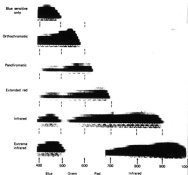As a result of a fairly spirited discussion yesterday I've been thinking about spectral sensitivity.
In particular, I've been thinking about how the spectral sensitivities compare between human vision, black and white film and various types (Selenium, CDs, Silicon, Gallium etc.) of exposure meters.
Can someone here provide a reference that would include some comparisons (ideally in graphical form) that would show the similarities and differences?
I'd like to be able to take better account of the differences when I am using exposure meters - particularly considering the fact that I have and use a variety of different exposure meters.
In particular, I've been thinking about how the spectral sensitivities compare between human vision, black and white film and various types (Selenium, CDs, Silicon, Gallium etc.) of exposure meters.
Can someone here provide a reference that would include some comparisons (ideally in graphical form) that would show the similarities and differences?
I'd like to be able to take better account of the differences when I am using exposure meters - particularly considering the fact that I have and use a variety of different exposure meters.






 .
.
